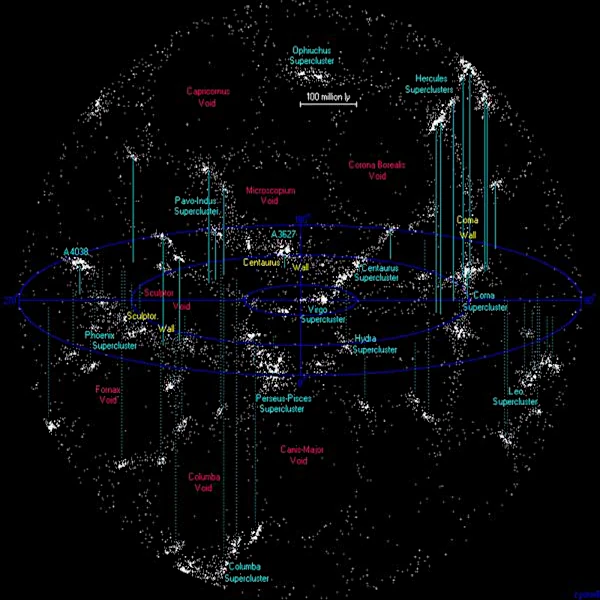
Image: Cosmologists have given names to the different large-scale structures of our Universe. The interior of the universe is composed of galaxy clusters, galaxy superclusters, supercluster complexes, cosmic filaments, Great Walls and cosmic voids.
The Coma filament contains the Coma supercluster of galaxies and is part of the CfA2 Great Wall.
Credit: Creative Commons (source)
The observable universe, that is to say the part of the universe that we can potentially observe, is extremely vast. However, the universe as a whole could be much larger still, and its exact extent beyond the observable universe is unknown.
Cosmologists have given names to the different structures in this vast expanse. The interior of the universe is composed of galaxy clusters, galaxy superclusters, supercluster complexes, cosmic filaments, Great Walls and cosmic voids.
In cosmology, the term "Great Wall" refers to several large-scale structures in the universe. These structures, several hundred million light years in size, are immense conglomerations of superclusters of galaxies, groups and filaments of galaxies, dark matter and gas interconnected by gravitational force.
The largest Great Walls are the Great Wall of Hercules-Crown Borealis (10 billion light years), the Huge-LQG (about 4 billion light years), the Great Wall of Sloan (about 1.37 billion light years), and the Great Wall CfA2 (about 700 million light years).
The study of such structures helps cosmologists better understand the formation and evolution of the universe on a large scale, as well as the distribution of matter in "space-time". Whether the universe as a whole is infinite or finite remains an open question in cosmology.
N.B.:
Our Galaxy does not belong to a "Great Wall", it is part of a local group of galaxies (Milky Way, Andromeda galaxy, Triangle galaxy and some dwarf galaxies), it is a small collection of galaxies. These galaxies are gravitationally bound to each other in a supercluster called the Virgo Supercluster. The Virgo Supercluster belongs to an even larger structure known as Laniakea, a supercluster of superclusters.
In cosmology, filaments are among the largest structures in the Universe.
A galactic filament is a wire-shaped structure (on the scale of the Universe), composed of galaxies and/or clusters of galaxies, gas and dark matter.
We know several filaments of several tens of megaparsecs (30 to 300 million light years), the Berenice's Hair filament, the Perseus-Pegasus filament, the Ursa Major filament, the Lynx-Great Dipper filament, the filament of Laniakea, the filament of Centauri, the filament of Virgo...
Laniakea, our supercluster of galaxies which integrates our Local Group and therefore the Milky Way, is not specifically associated with a single major cosmic filament. It is bounded by large filamentous structures and it is connected to other superclusters by these cosmic filaments.
N.B.:
One megaparsec (Mpc) is equivalent to one million parsecs. One parsec is approximately equal to 3.26 light years, and one megaparsec is therefore equivalent to approximately 3,260,000 light years.
A supercluster complex is a cosmic structure even larger than galaxy superclusters. Galaxy superclusters are massive concentrations of gravitationally bound galaxies, and supercluster complexes are even larger assemblages of these large-scale structures.
As far as we are concerned, the Fish-Whale supercluster complex is a vast cosmic structure that has been identified through large-scale observations of the sky. It is also known as Laniakea, a Hawaiian term meaning "huge open sky." This supercluster complex is of particular importance because it encompasses our own supercluster of galaxies, the Local Group, in which the Milky Way is located.
Laniakea is gigantic, spanning approximately 500 million light years. It brings together several superclusters of galaxies (Virgo Supercluster, Bouvier Supercluster, Serpent Supercluster, Hydra-Centaurus Supercluster, etc.).
The formation of supercluster complexes, cosmic filaments and Great Walls is closely linked to the structural growth processes of the universe.
Initially, in the "beginning" of the Universe, small fluctuations in the density of matter were amplified over time by gravitation, leading to the formation of these various large-scale structures.
The presence of dark matter plays a crucial role in the formation of these structures, as it acts as a kind of "gravitational glue" that attracts and holds ordinary matter, such as gas and galaxies, together.